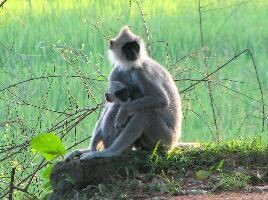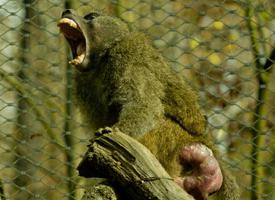
Weights and measures
| Weight | from 20 to 50 kg |
|---|---|
| Tail lenght | from 46 to 70 cm |
Biological data
| Lifespan | from 30 to 45 years |
|---|---|
| Length of gestation | from 175 to 180 d |
| Number of young | 1 |
Animal description
The Chacma baboon (Papio ursinus), also known as the Cape baboon, is a large and distinctive species of baboon that is native to various parts of southern Africa. This fascinating primate is known for its remarkable adaptability, intelligence, and complex social structure, making it a subject of interest both in the wild and in scientific research.Physically, the Chacma baboon is among the largest of the baboon species, with males significantly larger than females. Adult males can weigh up to 40 kilograms (about 90 pounds), while females are generally around half that size. They have a robust build with powerful limbs, both of which aid in their ability to traverse diverse terrains from grasslands to mountains. Their fur is generally dark brown to gray in color, with a slightly lighter underbelly. One of the most striking features of the Chacma baboon is its long, dog-like muzzle, which houses large canine teeth. These teeth play a crucial role in foraging, as well as in social displays and defense.
The face of the Chacma baboon is typically black, and they have large, expressive eyes. Their ears are relatively small and rounded. One of the distinctive features of this species is its rump, which is hairless and can appear in shades of red or pink, a characteristic that becomes more pronounced in females when they are in estrus.
Chacma baboons are highly social animals, living in troops that can number up to several hundred individuals. These troops are complex societies with a clear hierarchical structure, governed by both males and females. Male rankings are typically based on strength and alliances, while female hierarchy is lineage-based, with daughters inheriting their mother's rank. Social interactions within these troops are intricate and involve grooming, vocalizations, and body language, which help to strengthen bonds and maintain social order.
In terms of habitat, Chacma baboons are incredibly versatile. They are found in a variety of environments, from the savannas and woodlands to the mountains of southern Africa. Their adaptability extends to their diet as well; they are omnivorous, feeding on a wide array of foods, including fruits, seeds, grasses, insects, and occasionally small mammals and birds. This varied diet helps them to thrive in different habitats and conditions.
Reproduction in Chacma baboons is not seasonally bound, and females can give birth at any time of the year, typically to a single offspring after a gestation period of around six months. Infant baboons are highly dependent on their mothers for the first few months of life, not only for nutrition but also for transportation, as they cling to their mother's underside or ride on her back.
Chacma baboons play significant roles in their ecosystems, acting as seed dispersers and controlling insect populations. However, they are also known to come into conflict with humans, especially in areas where their habitats overlap with agricultural lands. These primates are known to raid crops and can become a nuisance, leading to conflicts that can negatively impact their populations.
Despite these challenges, the Chacma baboon is currently listed as a species of Least Concern by the International Union for Conservation of Nature (IUCN), indicating that it is not currently at immediate risk of extinction. However, habitat destruction, hunting, and human-wildlife conflict continue to pose threats to their populations in certain areas. Conservation efforts are therefore crucial to ensure the long-term survival of this remarkable and complex primate species in the wild.
Similar Animals
New photos of animals
Top 10 animals
- Dolphin gull (Leucophaeus scoresbii)
- Diana monkey (Cercopithecus diana)
- Moustached guenon (Cercopithecus cephus)
- Galápagos tortoise (Geochelone nigra complex)
- Stone loach (Barbatula barbatula)
- Japanese macaque (Macaca fuscata)
- Russian tortoise (Testudo horsfieldii)
- Greek tortoise (Testudo graeca)
- Common flying dragon (Draco volans)
- Vendace (Coregonus albula)


